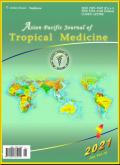马来西亚年轻人在实践健康生活以预防高血压方面的认识和感知障碍
IF 1.6
4区 医学
Q3 PUBLIC, ENVIRONMENTAL & OCCUPATIONAL HEALTH
引用次数: 1
摘要
目的:调查马来西亚年轻人对健康生活预防高血压的知识、态度和实践水平以及感知障碍。方法:采用方便抽样的方法招募居住在马来西亚的18-25岁成年人。评估了社会形态特征、高血压医学知识(K1)、知识(K)、态度(A)、实践(P)以及实施健康生活预防高血压的感知障碍。平均得分分为好(80%-100%)、中上(70%-79%)、中下(60%-69%)和差(<60%)。进行多变量分析以检验变量之间的差异和关系。Pearson相关检验用于检验两个连续变量的相关性。结果:共有1218名受访者参与了这项调查。K1的平均得分为54.1%,对健康生活的知识、态度和实践分别为82.7%、78.2%和68.5%。高盐摄入、高脂肪摄入、低纤维摄入、久坐不动的生活方式和缺乏年度健康检查的患病率分别为83.2%、81.4%、70.3%和73.2%。BMI异常与低P分相关,而社会经济地位较低、对自身血压读数不了解以及没有高血压家族史的人与K1、K、A和P分较低相关。主要的感知障碍包括自称身体健康、经常食用户外食物以及对高盐/高脂肪食物上瘾。结论:国家健康管理战略应优先考虑减少盐和脂肪,促进该年龄组的年度健康检查、体育活动和纤维摄入。本文章由计算机程序翻译,如有差异,请以英文原文为准。
Awareness and perceived barriers in practicing healthy living to prevent hypertension among young adults in Malaysia
Objective: To investigate the knowledge, attitude, and practice levels and perceived barriers towards healthy living to prevent hypertension among young adults in Malaysia. Methods: Adults aged 18-25 years reside in Malaysia were recruited via convenience sampling. Sociodemographic characteristics, medical knowledge on hypertension (K1), knowledge (K), attitude (A), practice (P) and perceived barriers in practising healthy living to prevent hypertension were assessed. Average scores were categorised into good (80%-100%), upper-moderate (70%-79%), lower-moderate (60%-69%) and poor (<60%). Multivariate analysis was performed to test the difference and relationship of variables. Pearson correlation test was used to test the association of two continuous variables. Results: A total of 1 218 respondents participated in this survey. The mean score of K1 was 54.1%, while the knowledge, attitude, and practice towards healthy living were 82.7%, 78.2%and 68.5% respectively. The prevalence of high salt intake, high fat intakes, low fibre intake, sedentary lifestyle and lack of annual health screening was 83.2%, 81.4%, 70.3%, and 73.2%, respectively. Abnormal BMI was associated with low P scores, while lower socio-economic status, unawareness of self-blood pressure reading and those without family history of hypertension were associated with lower scores in K1, K, A, and P. K1, K, A and P are significantly inter-related. The main perceived barriers included self-proclaimed good fit status, frequent consumption of out-of-home food, and addiction to high salt/fat food. Conclusions: The national strategies for health management should be prioritized in reducing salt and fat, promoting annual health screening, physical activities and fibre intake in this age group.
求助全文
通过发布文献求助,成功后即可免费获取论文全文。
去求助
来源期刊

Asian Pacific journal of tropical medicine
PUBLIC, ENVIRONMENTAL & OCCUPATIONAL HEALTH-TROPICAL MEDICINE
CiteScore
4.00
自引率
9.70%
发文量
1936
审稿时长
3-8 weeks
期刊介绍:
Asian Pacific Journal of Tropical Medicine (ISSN 1995-7645 CODEN: APJTB6), a publication of Editorial office of Hainan Medical University,is a peer-reviewed print + online Monthly journal. The journal''s full text is available online at http://www.apjtm.org/. The journal allows free access (Open Access) to its contents and permits authors to self-archive final accepted version of the articles on any OAI-compliant institutional / subject-based repository.
APJTM aims to provide an academic communicating platform for international physicians, medical scientists, allied health scientists and public health workers, especially those of the Asia-Pacific region and worldwide on tropical medicine, infectious diseases and public health, and to meet the growing challenges of understanding, preventing and controlling the dramatic global emergence and re-emergence of infectious diseases in the Asia-Pacific.
The journal is proud to have an international and diverse editorial board that will assist and facilitate the publication of articles that reflect a global view on tropical medicine, infectious diseases and public health, as well as emphasizing our focus on supporting the needs of public health practitioners. The APJTM will allow us to seek opportunities to work with others who share our aim, and to enhance our work through partnership, and to uphold the standards of our profession and contribute to its advancement.
 求助内容:
求助内容: 应助结果提醒方式:
应助结果提醒方式:


